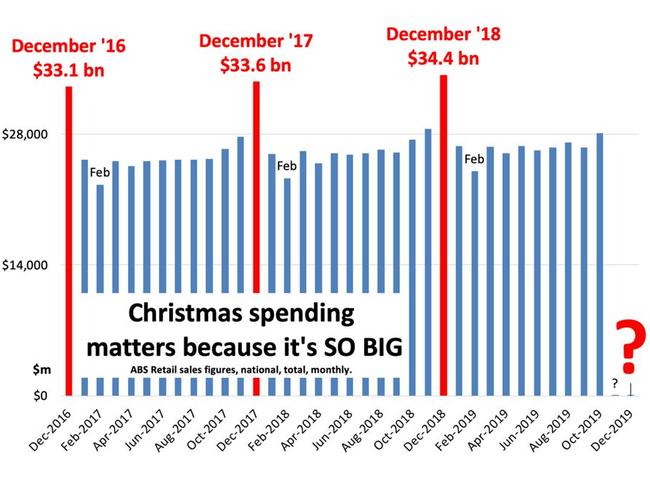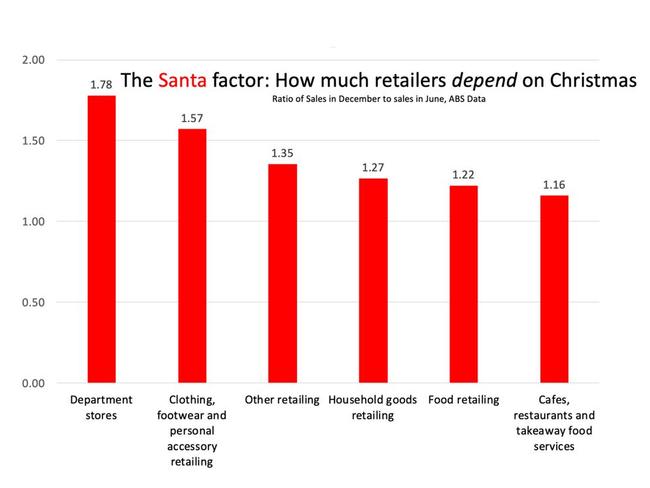‘A vicious cycle’: ‘Bleak’ Christmas sign in Aussie shops
Something very strange is happening in shopping centres and department stores across Australia right now – and it is bad news for all of us.

Retail
Don't miss out on the headlines from Retail. Followed categories will be added to My News.
COMMENT
Have you been to the shops yet? This Christmas, the mall near me seems a bit empty. That makes me nervous. Because Australia needs a really big Christmas to keep the economy going into 2020.
As the next graph shows, Christmas spending is a big deal to the Australian economy. We spend a lot. Last December we spent $34 billion dollars in that month alone – over a billion dollars a day. The rest of the year we spend a lot less.

When we spend money at the shops, it gets spread around. The most obvious place it goes is all those Christmas casuals, and there’s a lot of them. Employment spikes every December. Last year, fully 100,000 more people were employed in December than November.
Those people spend that money in lots of ways – on presents for family, on food, on rent. Every dollar they earn is likely to get thrown right back into the big whirlpool of activity we call the Australian economy and keep it going.
But it’s not just the money in their pockets, it flows through to logistics and utilities and real estate and many other industries. Christmas spending is where many companies make the money that employs the rest of us for the rest of the year.
Whether you work in retail or government, construction or health, Christmas spending helps you. More spending in the economy creates more jobs and more tax revenue, which leads to more spending by both consumers and government. It’s a big virtuous cycle.
NOT ALL CYCLES ARE VIRTUOUS
Recently we’ve not been in much of a virtuous cycle. We’ve been in the opposite – a vicious cycle.
If you look at Australian consumer spending, recent weak wages growth is disappointing and we are worried about the future. Australian retail spending growth has been weak. Check that graph above again. See October 2019, the most recent data? It’s actually lower than October 2018. Not a good sign for the Christmas to come. Not a good sign at all.
Australia’s saving rate has shot up as the next graph shows. We almost finally looked to be getting back to pre-GFC levels, but then there was a big reversal.

Our sudden saving was revealed in the most recent national accounts data. The government doled out extra tax cuts, but we decided not to spend them. When the future looks bleak and murky, who can blame us? The problem is this thrift – individually virtuous – creates a vicious cycle when we all do it at the same time.
WHO DEPENDS MOST?
When Christmas spending is absent, some industries feel it more than others because they depend on Christmas for so much of their sales.
Department stores feel it in particular. They actually make more money in December than in January and February combined. If December sales are not as good as they want, it will take many months to catch up.
Department stores sell a whopping 78 per cent more in December than June as the next graph shows.

If Christmas sales slump, department stores will be where we notice it first. They are the kind of stores most likely to get wobbly after a bad Christmas.
As the graph shows, clothing and footwear retailers are in second place. They are also begging for your Christmas spending.
Food retailing is also bigger at Christmas time – around 22 per cent stronger in December than June because we spend so much on turkey and ham.
Cafes and restaurants are at the other end of the scale. December is their biggest month but only just. They are least dependent on strong sales in December – they sell only 16 per cent more in December than June.
What this means is that if Christmas spending is weak in 2019, Harris Scarfe might be followed into administration by other department stores. I’m not saying Myer is at that point, but their share price has fallen around 9 per cent since the start of December.
So please, if you have the money, get out there and spend it. Not only will it be good for the smiles of all the people who get presents from you in December, but it’s what the country needs to keep all of us in jobs in 2020. I’ll see you at the shops.
Jason Murphy is an economist | @jasemurphy. He is the author of the new book Incentivology.
Originally published as ‘A vicious cycle’: ‘Bleak’ Christmas sign in Aussie shops

